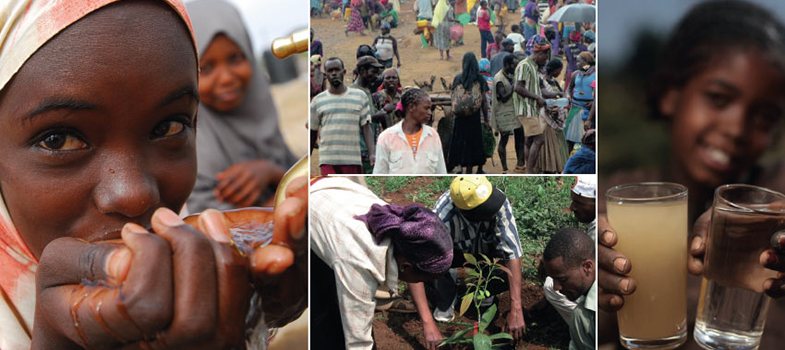14.2 OWNP planning process
The overall planning process of the OWNP involved two broad steps. First, the country's WASH status (before 2013) was assessed; service levels and problems were also identified. Then, goals were set to address the problems or increase service levels to reach the intended targets. The targets to be achieved, as you read in Study Session 2, had been set out in the Universal Access Plan (UAP) and the National Hygiene and Sanitation Strategic Action Plan (SAP). Box 14.1 reminds you of these important targets.
Box 14.1 Original targets for the OWNP
The Government of Ethiopia (GoE) set out its goals in the Growth and Transformation Plan (GTP). This identified water and sanitation as priority areas for achieving sustainable growth and poverty reduction. In line with the GTP, the GoE prepared the Universal Access Plan (UAP) with the following targets, which were adopted for the OWNP:
- 98.5% access to water supply (100% for urban populations and 98% for rural areas)
- reduction of the proportion of non-functioning water supply services to 10%
- 100% access to basic sanitation (improved and unimproved)
- 77% of the population to practise handwashing at critical times
- 77% of the population to practise safe water handling and water treatment in the home
- 80% of communities to achieve open defecation free (ODF) status.
The 98.5% target for water supply is derived from the average for all regions. In most regions the target is 100% but in Somali and Afar the regional water supply targets are 74% and 75% respectively. These lower figures reflect the challenges of providing water services in these pastoralist regions. The effect of these lower targets on the overall figure (only 1.5% less than 100%) is due to the relatively low population density in these two regions. The ultimate target is 100% for the entire country.
The Programme was divided into two phases over the full seven-year duration to allow review and adjustment at the end of 2015 when the GTP, UAP and Millennium Development Goals periods ended. It was foreseen that there could be changes in GoE policies, strategies and plans at that time, so the end of Phase 1 was timed to allow for these changes to be accommodated in Phase 2 of the Programme, which was originally planned for 2016–2020.
(It should be noted that the schedule has since changed. Full implementation of the Programme, which was planned for 2013, did not start until late 2014. This followed the endorsement of the Programme Operational Manual (POM) in September 2014 and the opening of the Consolidated WASH Account at MoFED to receive funds from donors.)
By comparing these targets with the situation at the outset, the size of the task could be defined and possible solutions identified. From Study Session 13, you know about the detailed targets for new and improved services that were itemised in the results framework. Once the number and scale of all the new services required had been identified, then cost estimates for each could be made, which added up to the total budget required for the Programme. OWNP planning used two complementary processes on which to base the estimates of work required and budget. The two processes were:
- Projections based on updated models used in preparing the Universal Access Plan (UAP) and Strategic Action Plan (SAP).
- A process based on information received from the regions and towns.
Budget estimates from these two processes were approximately the same and the figure of US$2.41 billion was taken as the overall OWNP planned budget.
14.1 Introduction to planning
